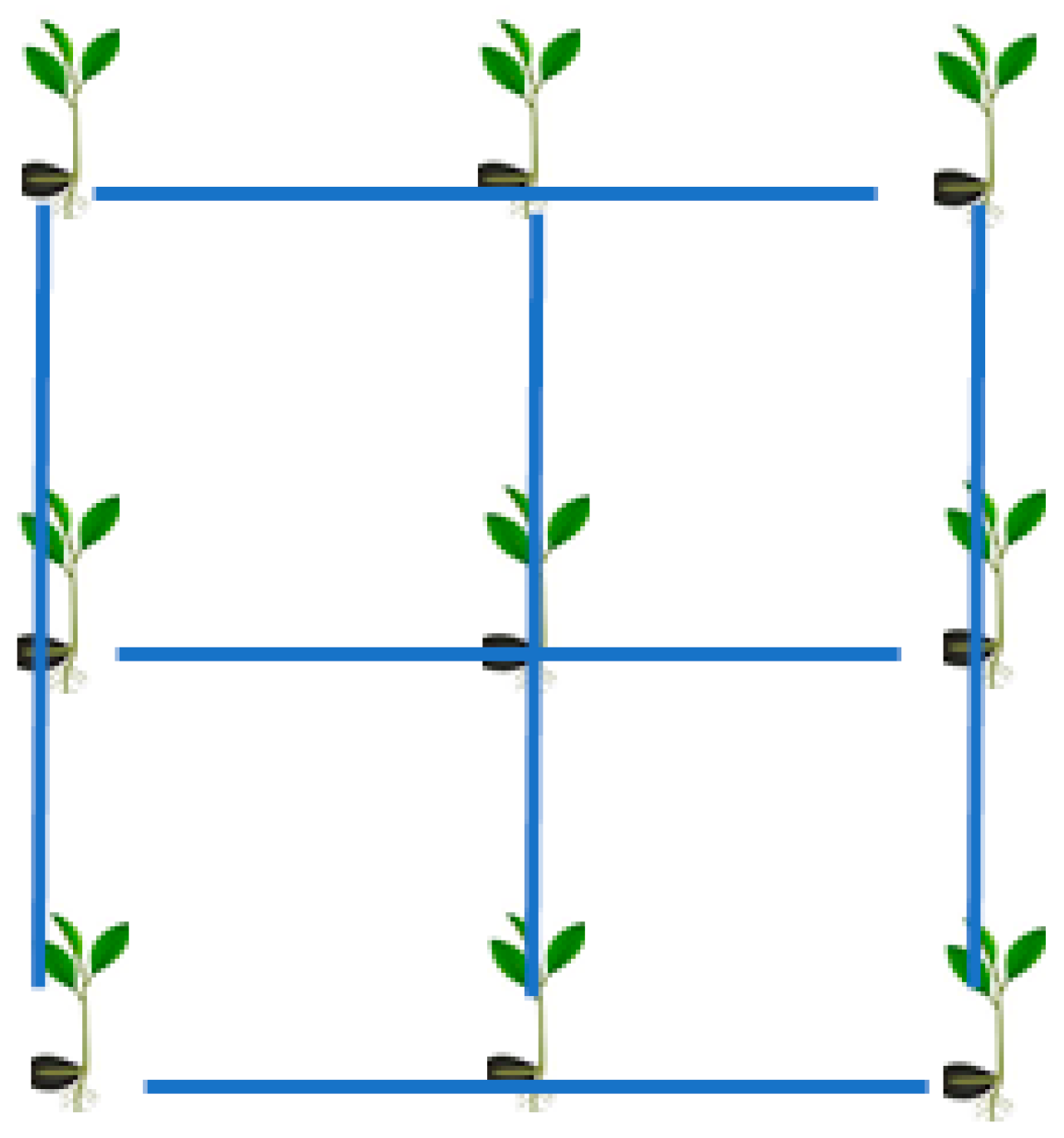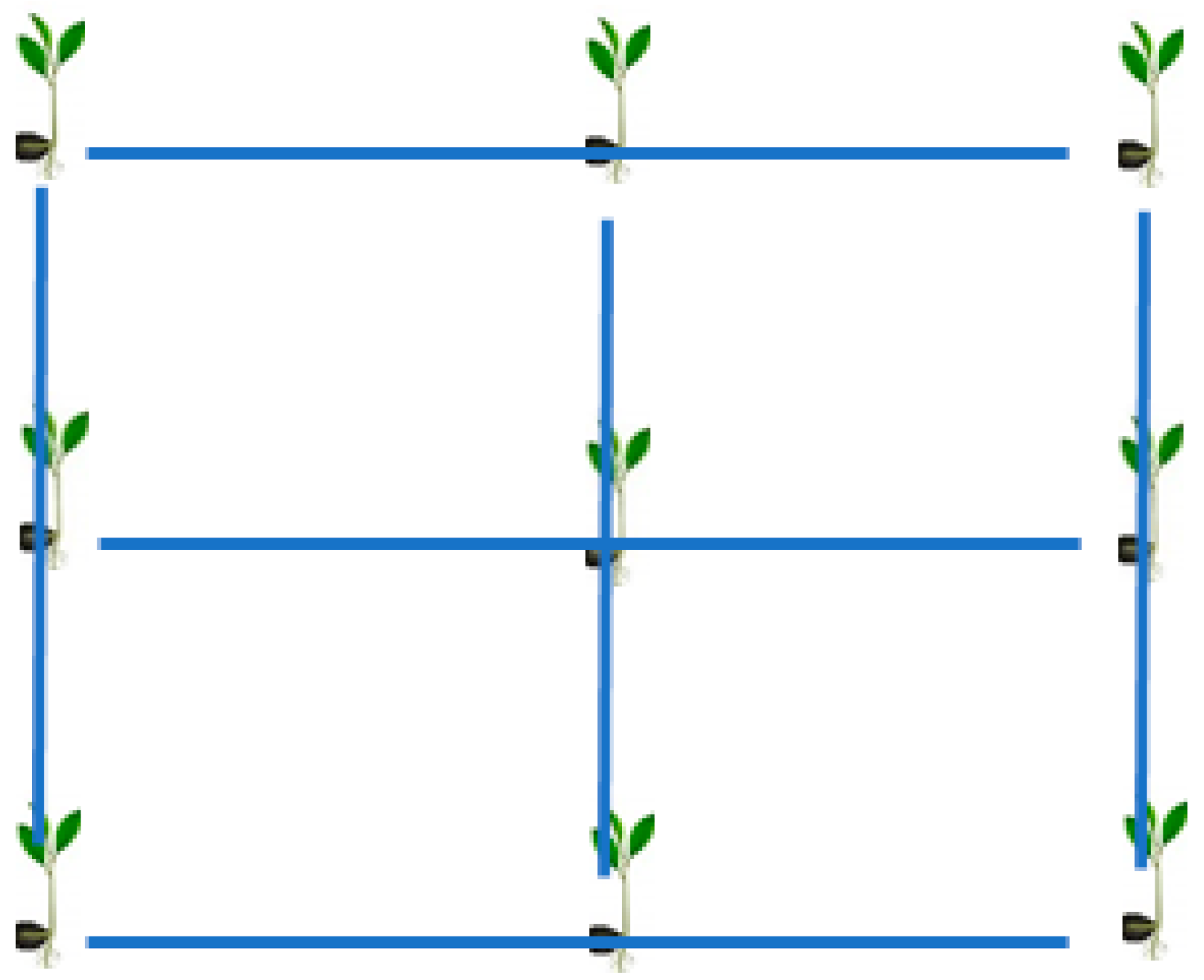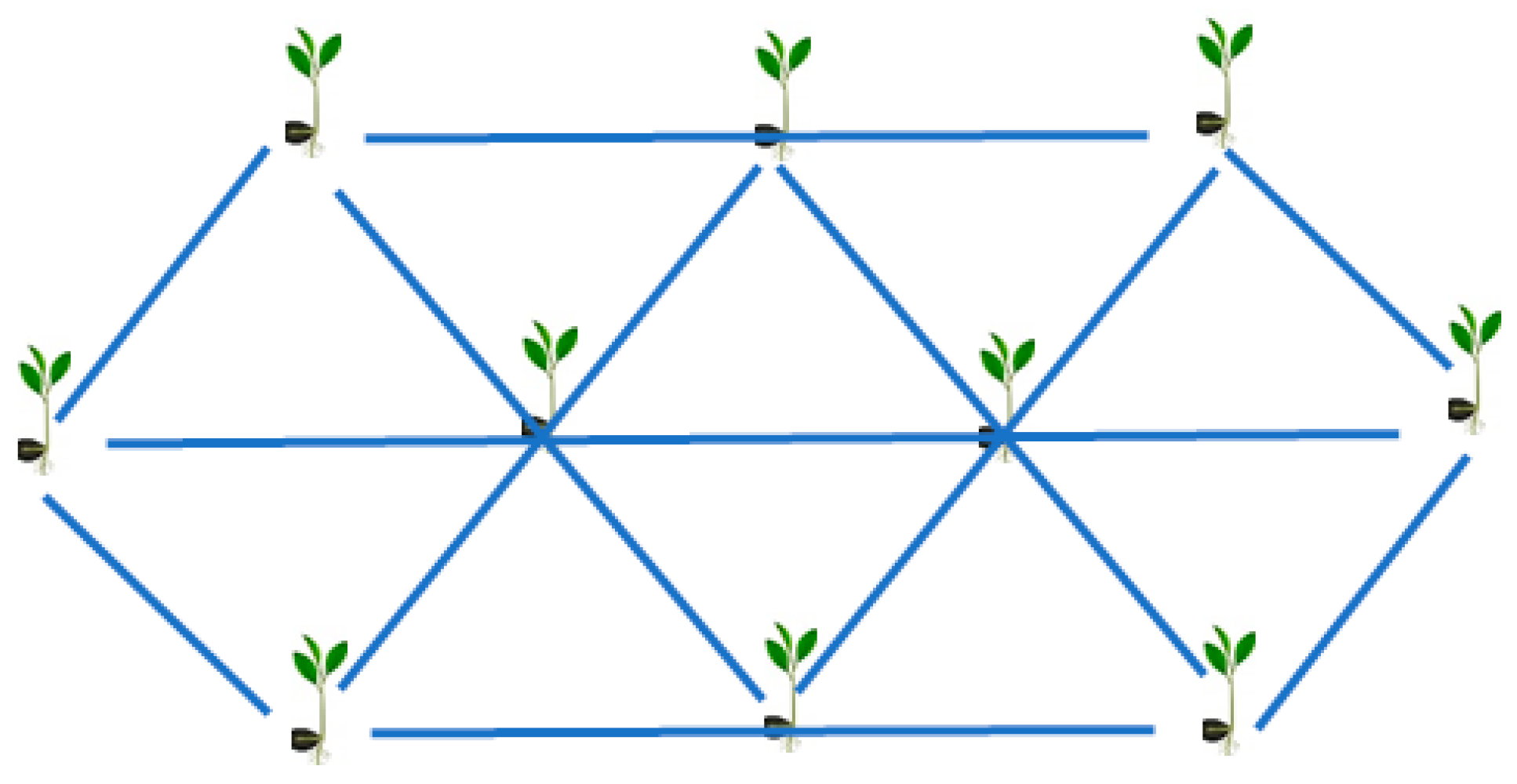
| Version | Summary | Created by | Modification | Content Size | Created at | Operation |
|---|---|---|---|---|---|---|
| 1 | Mohammad Amdadul Haque | -- | 3150 | 2022-08-30 18:22:54 | | | |
| 2 | Lindsay Dong | Meta information modification | 3150 | 2022-08-31 03:19:40 | | |
Video Upload Options
Plant density refers to the number of individual plants per unit of ground area. In an ideal plant population, the capability of the plant canopy to collect environmental resources, including radiation energy, water, and inorganic nutrients, can be improved. A dense plant population increases the competition between plants for resources, which results in limited resources being depleted. Additionally, improved canopy construction can lead to an optimal leaf area index that can boost photosynthetic ability through efficient solar radiation interception. High densities of plants encourage better productivity; lower densities, in general, allow for the harvesting of more large fruits, resulting in higher pricing on the fresh fruit market. Higher planting density is used for higher yields without increasing production costs.
1. Introduction
The selection of the appropriate density is critical for optimizing the yield potential. The optimal plant density should be kept for the maximum possible yields of good quality fruit. Increased plant population density improves the interception of solar radiation and water use efficiency [1], which helps to boost canopy photosynthetic capacity and biomass production [2], thus increasing yield and water productivity [3]. As a result of the optimal planting density, crop yield and quality are improved, while the need for fertilizer and labour is reduced [4]. However, when planting density exceeds a certain threshold, the yield tends to be reduced [5] due to an inadequate supply of carbon and nitrogen, because of intense interplant competition for sunlight, soil nutrients, and water. In modern cropping systems, high plant density in planting is one of the most important agronomic approaches [6]. Maximum yield occurs when the spatial plant density allows for the maximum leaf area index to be given by the rapid growth of the leaf canopy, enabling maximum solar radiation interception as early as possible in the growing season [7]. Plant population density has been a vital variable in yield enhancement studies [8]. As plant density increases, the distribution of resources on the plant scale (soil water, fertility of the soil, light interception) decreases, increasing competition between plants and, in turn, reducing the potential of individual plant yield [9]. The probability of negative effects increases when the density reaches the optimal level for a given area [10]. One of the best management practices to increase yield is the selection of sufficient planting density to maximize light interception, as crop productivity is highly influenced by the total solar radiation intercepted by the crop. Generally, with rising planting density, and solar radiation obtained by the crop increases, the higher planting density is also found to have higher total yields [3]. High plant density associated with shading may lead to disease infestation, the shedding of fruit, reduced fruit size, delayed maturity, and decreased individual plant growth and light interception [11].
Crop spatial arrangement is another agronomic component that might affect the yield [12] and crop competition against weeds [13]. This pattern can also affect plant growth, and development [14]. Uniform planting patterns reduce mutual shade and hasten canopy closure in increasing the leaf area index (LAI). All of these factors contribute to the canopy’s improved radiation interception [15], which boosts crop growth and production [16]. The equal spacing of crops, on the other hand, may restrict light penetration or change the illumination quality under the crop canopy. Some weed seeds may not germinate, weed seedlings may not flourish, and weed seed production may be reduced [16]. When there is a uniform distribution, intraspecific competition within a crop is prolonged, but interspecific competition with weeds begins sooner. This permits the crop population to shade out the weeds and prevent them from re-emerging in large numbers [17]. Planting arrangement, or planting pattern, might be an important determining factor for individual plant performance [18]. The planting arrangement of the crop is the most important management aspect that determines the crop structure and can alter crop yield–density relationships [19].
2. Planting Arrangement of Fruit Crops
2.1. Vertical Row Planting Pattern


2.2. Alternate Row Planting Pattern
2.2.1. Hexagonal Pattern of Planting
Within this system, trees are planted in equilateral triangle corners. Six trees are arranged in a hexagon, with another tree in the centre of the hexagon (Figure 3). Though it is a bit difficult to implement, it allows for 15% more plants. With this system, it is possible to cultivate land in three directions between the plant rows. In general, this system is used when the land is expensive, fertile, and irrigation water is abundant. If the distance between rows and plants remains the same, the hexagonal system could accommodate 15% more plants than the square system [23].

2.2.2. Triangular Pattern of Planting

2.2.3. Diagonal or Quincunx Pattern of Planting

2.2.4. Contour Pattern of Planting

3. The Benefit of Planting Density
4. Factors to Be Considered for Planting Density
5. Impact of Plant Density on the Use of Resources
6. Planting Density on the Growth and Development of Fruit Crops
7. Planting Density on Chlorophyll Content of Fruit Crops
8. Planting Density on Fruit Yield
9. Planting Density on Fruit Quality
Measures of fruit quality include both internal and external properties. The internal quality is mainly determined by aroma, flavor, taste, texture, and nutritional quality (e.g., soluble sugar content, starch, organic acids, soluble solids content, carotenoids, total flavonoids, total phenolics, antioxidant activity, etc.), flesh firmness, diseases, and chemical residues. The external quality mainly concerns appearance, size, color, and bruises. Fruit quality depends on the distance of planting. Sarrwy et al. [56] confirmed that soluble solids concentration (% Brix) and total sugars (%) were measured from the highest plant spacing (3 × 4 m) with three plants at every hole. Another study by Chaudhury and Baruah [57] reported that the plants that are raised under low density exhibited superior fruit quality in terms of SSC, total sugar, and sugar-to-acid ratio. These parameters tended to decrease as plant density increased. In contrast, titratable acidity and non-reducing sugar showed the opposite trend. The higher acidity in a higher plant population may be due to the shade effect, where sugar conversion from organic acid is hampered due to a lack of sufficient light. Moreover, lower reducing sugar and higher non-reducing sugar in the high-density plot may be due to a lower conversion of sugar from starch.
10. Conclusions
References
- Jiang, X.; Tong, L.; Kang, S.; Li, F.; Li, D.; Qin, Y.; Shi, R.; Li, J. Planting density affected biomass and grain yield of maize for seed production in an arid region of Northwest China. J. Arid Land 2018, 10, 292–303.
- Ceotto, E.; Di Candilo, M.; Castelli, F.; Badeck, F.W.; Rizza, F.; Soave, C.; Volta, A.; Villani, G.; Marletto, V. Comparing solar radiation interception and use efficiency for the energy crops giant reed (Arundo donax L.) and sweet sorghum (Sorghum bicolor L. Moench). Field Crops Res. 2013, 149, 159–166.
- Qiu, R.; Song, J.; Du, T.; Kang, S.; Tong, L.; Chen, R.; Wu, L. Response of evapotranspiration and yield to planting density of solar greenhouse grown tomato in northwest China. Agric. Water Manag. 2013, 130, 44–51.
- Zhi, X.Y.; Han, Y.C.; Li, Y.B.; Wang, G.P.; Du, W.L.; Li, X.X.; Mao, S.C.; Feng, L. Effects of plant density on cotton yield components and quality. J. Integr. Agric. 2016, 15, 1469–1479.
- Griesh, M.H.; Yakout, G.M. Effect of plant population density and nitrogen fertilization on yield and yield components of some white and yellow maize hybrids under drip irrigation system in sandy soil. Plant Nutr. 2001, 1, 810–811.
- Xu, C.; Huang, S.; Tian, B.; Ren, J.; Meng, Q.; Wang, P. Manipulating planting density and nitrogen fertilizer application to improve yield and reduce environmental impact in Chinese Maize production. Front. Plant Sci. 2017, 8, 1234.
- Ruffo, M.L.; Gentry, L.F.; Henninger, A.S.; Seebauer, J.R.; Below, F.E. Evaluating management factor contributions to reduce corn yield gaps. Agron. J. 2015, 107, 495–505.
- Assefa, Y.; Vara Prasad, P.V.; Carter, P.; Hinds, M.; Bhalla, G.; Schon, R.; Jeschke, M.; Paszkiewicz, S.; Ciampitti, I.A. Yield responses to planting density for US modern corn hybrids: A synthesis-analysis. Crop Sci. 2016, 56, 2802–2817.
- Luo, N.; Wang, X.; Hou, J.; Wang, Y.; Wang, P.; Meng, Q. Agronomic optimal plant density for yield improvement in the major maize regions of China. Crop Sci. 2020, 60, 1580–1590.
- Assefa, Y.; Carter, P.; Hinds, M.; Bhalla, G.; Schon, R.; Jeschke, M.; Paszkiewicz, S.; Smith, S.; Ciampitti, I.A. Analysis of long term study indicates both agronomic optimal plant density and increase maize yield per plant contributed to yield gain. Sci. Rep. 2018, 8, 4937.
- Yang, G.Z.; Luo, X.J.; Nie, Y.C.; Zhang, X.L. Effects of plant density on yield and canopy micro environment in hybrid cotton. J. Integr. Agric. 2014, 13, 2154–2163.
- Isaac, A.A.; Oyebisi, A.K.; Kayode, O.S.; Mojisola, A.S. Effects of spatial arrangement and population density on the growth and yield of sesame (Sesamum indicum L.) in a sesame/maize intercrop. J. Agric. Sci. 2020, 65, 337–350.
- Olsen, J.M.; Griepentrog, H.-W.; Nielsen, J.; Weiner, J. How important are crop spatial pattern and density for weed suppression by spring wheat? Weed Sci. 2012, 60, 501–509.
- Zhou, X.B.; Chen, Y.H.; Ouyang, Z. Spacing between rows: Effects on water-use efficiency of double-cropped wheat and soybean. J. Agric. Sci. 2015, 153, 90–101.
- Olsen, J.; Weiner, J. The influence of Triticum aestivum density, sowing pattern and nitrogen fertilization on leaf area index and its spatial variation. Basic Appl. Ecol. 2007, 8, 252–257.
- Mashingaidze, A.B.; Van Der Werf, W.; Lotz, L.A.P.; Chipomho, J.; Kropff, M.J. Narrow rows reduce biomass and seed production of weeds and increase maize yield. Ann. Appl. Biol. 2009, 155, 207–218.
- Weiner, J.; Andersen, S.B.; Wille, W.K.M.; Griepentrog, H.W.; Olsen, J.M. Evolutionary Agroecology: The potential for cooperative, high density, weed-suppressing cereals. Evol. Appl. 2010, 3, 473–479.
- Lindquist, J.L.; Rhode, D.; Puettmann, K.J.; Maxwell, B.D. The influence of plant population spatial arrangement on individual plant yield. Ecol. Appl. 1994, 4, 518–524.
- Satorre, E.H.; Maddonni, G.A. Spatial Crop Structure in Agricultural Systems. In Encyclopedia of Sustainability Science and Technology; Meyers, R.A., Ed.; Springer: New York, NY, USA, 2019; pp. 1–17. ISBN 9781493924936.
- Whitely, K.T. Orchard planting systems. J. Dep. Agric. West. Aust. 1962, 3, 465–467.
- Usman, M.; Khan, M.M. Planning and orchard establishment. In The lime Botanly, Production and Uses; Khan, M.M., Al-Yahyai, R., Al-Said, F., Eds.; CABI Publishing Wallingford: Boston, MA, USA, 2017.
- Esmaeilzadeh, S.; Aminpanah, H. Efeito da Época de plantio e do arranjo espacial em feijoeiro comum (phaseolus vulgaris) com e sem infestação de plantas daninhas. Planta Daninha 2015, 33, 425–432.
- Usha, K.; Thakre, M.; Goswami, A.K.; Deepak, N.G. Fundamental of Fruit Production; Usha, K., Thakre, M., Goswami, A.K., Deepak, N.G., Eds.; Indian Agricultural Research Institute: New Delhi, India, 2015.
- Dhawan, S.S. Experiment 1 Layout of an Orchard. In Practical Manual-Horticulture and Agroforestry System; IGNOU: New Delhi, India, 2018; pp. 5–7.
- Chauhan, B.S.; Opeña, J.L. Effect of plant spacing on growth and grain yield of soybean. Am. J. Plant Sci. 2013, 4, 2011–2014.
- Orchard Management Horticulture. Available online: https://agritech.tnau.ac.in/horticulture/horti_orchardmanagement.html (accessed on 5 August 2021).
- Blandino, M.; Reyneri, A.; Vanara, F. Effect of plant density on toxigenic fungal infection and mycotoxin contamination of maize kernels. Field Crops Res. 2008, 106, 234–241.
- Moral, J.; Jurado-Bello, J.; Sánchez, M.I.; De Oliveira, R.; Trapero, A. Effect of temperature, wetness duration, and planting density on olive anthracnose caused by Colletotrichum spp. Phytopathology 2012, 102, 974–981.
- Andrianirina, Z.T.; Martin, M.; Dongmeza, E.; Senger, E. Effects of genotype, direct sowing and plant spacing on field performance of Jatropha curcas L. Agronomy 2019, 9, 465.
- Turner, N.C. Agronomic options for improving rainfall-use efficiency of crops in dryland farming systems. J. Exp. Bot. 2004, 55, 2413–2425.
- Waddington, E. Plant Spacing in Your Garden—How to Get It Right|Polytunnel Gardening. Available online: https://blog.firsttunnels.co.uk/plant-spacing/ (accessed on 5 August 2021).
- Kumar, N. Introduction to Horticulture; CBS Publishers & Distributors Pvt., Limited: New Delhi, India, 2016; ISBN 8120417542.
- Asik, B.B.; Uzun, A.; Acikgöz, E. Seeding rate and cultivar impacts on nutrient uptake of field pea under fertile soil condition. Chil. J. Agric. Res. 2020, 80, 11–20.
- Tandel, B.; Patel, B.; Patel, D.; Raj, V.C.; Patil, P.; Patel, A.M.; Patel, D.U. Sugarcane yield and nutrient uptake under plant geometry and variety in relation to mechanization. Bioscan 2014, 9, 1445–1448.
- Li, Y.S.; Yu, C.B.; Zhu, S.; Xie, L.H.; Hu, X.J.; Liao, X.; Liao, S.; Che, Z.; Li, Y.S.; Yu, C.B.; et al. High planting density benefits to mechanized harvest and nitrogen application rates of oilseed rape (Brassica napus L.). Soil Sci. Plant Nutr. 2014, 60, 384–392.
- Robinson, T.L. Recent advances and future directions in orchard planting systems. In Proceedings of the VIII International Symposium on Canopy, Rootstocks and Environmental Physiology in Orchard Systems, Budapest, Hungary, 13–18 June 2004; pp. 367–381.
- Craine, J.M.; Dybzinski, R. Mechanisms of plant competition for nutrients, water and light. Funct. Ecol. 2013, 27, 833–840.
- Tang, L.; Ma, W.; Noor, M.A.; Li, L.; Hou, H.; Zhang, X.; Zhao, M. Density resistance evaluation of maize varieties through new “Density–Yield Model” and quantification of varietal response to gradual planting density pressure. Sci. Rep. 2018, 8, 17281.
- Bora, K.K.; Singh, K.; Kumar, A.; Kakralya, B.L. Stress and Environmental Plant Physiology; Pointer Publishers: Jaipur, India, 2001; ISBN 8171322913.
- Gezahegn, A.M. Review on effect of plant density and planting arrangement on Faba bean production. World J. Agric. Sci. 2019, 15, 261–268.
- Pandey, R.; Paul, V.; Das, M.; Meena, M.; Meena, R.C. Plant growth analysis. In Manual of ICAR Sponsored Training Programme on “Physiological Techniques to Analyze the Impact of Climate Change on Crop Plants”; The Division of Plant Physiology IARI: New Delhi, India, 2017; pp. 103–107.
- Matthews, P.W.; Carpenter, D.J.; Smith, A.; Fettell, N.A. Faba bean seeding rates for central and southern NSW. Icarus 2001, 3, 1–4.
- Singh, N.P.; Singh, R.A. Scientific Crop Production; Press Graph: New Delhi, India, 2002.
- Weraduwage, S.M.; Chen, J.; Anozie, F.C.; Morales, A.; Weise, S.E.; Sharkey, T.D. The relationship between leaf area growth and biomass accumulation in Arabidopsis thaliana. Front. Plant Sci. 2015, 6, 167.
- Streck, N.A.; Pinheiro, D.G.; Junior Zanon, A.; Gabriel, L.F.; Rocha, T.S.M.; de Souza, A.T.; Silva, M.R. da Effect of plant spacing on growth, development and yield of cassava in subtropical environment. Bragantia 2014, 73, 407–415.
- Patil, P.; Biradar, P.; Bhagawathi, A.U.; Hejjegar, I.S. A review on leaf area index of horticulture crops and its importance. Int. J. Curr. Microbiol. Appl. Sci. 2018, 7, 505–513.
- Fang, X.; Li, Y.; Nie, J.; Wang, C.; Huang, K.; Zhang, Y.; Zhang, Y.; She, H.; Liu, X.; Ruan, R.; et al. Effects of nitrogen fertilizer and planting density on the leaf photosynthetic characteristics, agronomic traits and grain yield in common buckwheat (Fagopyrum esculentum M.). Field Crops Res. 2018, 219, 160–168.
- Debnath, S.; Bauri, F.K.; Bandyopadhyay, B.; Misra, D.K.; Mandal, K.K.; Murmu, I.; Patil, P. Identification of optimum leaf area index (LAI) for high density planting of banana cv. martaman in Gangetic Alluvium region of West Bengal. J. Crop Weed 2015, 11, 63–66.
- Yahia, E.M.; Carrillo-López, A.; Barrera, G.M.; Suzán-Azpiri, H.; Bolaños, M.Q. Photosynthesis. In Postharvest Physiology and Biochemistry of Fruits and Vegetables; Elsevier Inc.: Duxford, UK, 2018; pp. 47–72. ISBN 9780128132784.
- Ladaniya, M.S.; Marathe, R.A.; Murkute, A.A.; Huchche, A.D.; Das, A.K.; George, A.; Kolwadkar, J. Response of Nagpur mandarin (Citrus reticulata Blanco) to high density planting systems. Sci. Rep. 2021, 11, 10845.
- Tripathi, A.; Sehrawat, S.K.; Dahiya, D.S. Effect of spacing and pruning on chlorophyll and NPK contents of guava leaves cv. Hisar Safeda. Int. J. Chem. Stud. 2020, 8, 1039–1041.
- Ladaniya, M.S.; Marathe, R.A.; Das, A.K.; Rao, C.N.; Huchche, A.D.; Shirgure, P.S.; Murkute, A.A. High density planting studies in acid lime (Citrus aurantifolia Swingle). Sci. Hortic. 2019, 261, 108935.
- Khan, N.; Han, Y.; Xing, F.; Feng, L.; Wang, Z.; Wang, G.; Yang, B.; Fan, Z.; Lei, Y.; Xiong, S.; et al. Plant density influences reproductive growth, lint yield and boll spatial distribution of cotton. Agronomy 2020, 10, 14.
- Ajayakumar, M.Y.; Umesh, M.R.; Shivaleela, S.; Nidagundi, J.M. Light interception and yield response of cotton varieties to high density planting and fertilizers in sub-tropical India. J. Appl. Nat. Sci. 2017, 9, 1835–1839.
- Venugopalan, M.V.; Kranthi, K.R.; Blaise, D.; Lakde, S.; Sankaranarayana, K. High density planting system in cotton-The Brazil experience and Indian initiatives. Cott. Res. J. 2013, 5, 172–185.
- Sarrwy, S.M.A.; Mostafa, E.A.M.; Hassan, H.S.A. Growth, yield and fruit quality of Williams banana as affected by different planting distances. Int. J. Agric. Res. 2012, 7, 266–275.
- Chaudhuri, P.; Baruah, K. Studies on planting density in banana cv. ‘Jahaji’ (AAA). Indian J. Hill Farming 2010, 23, 31–38.




